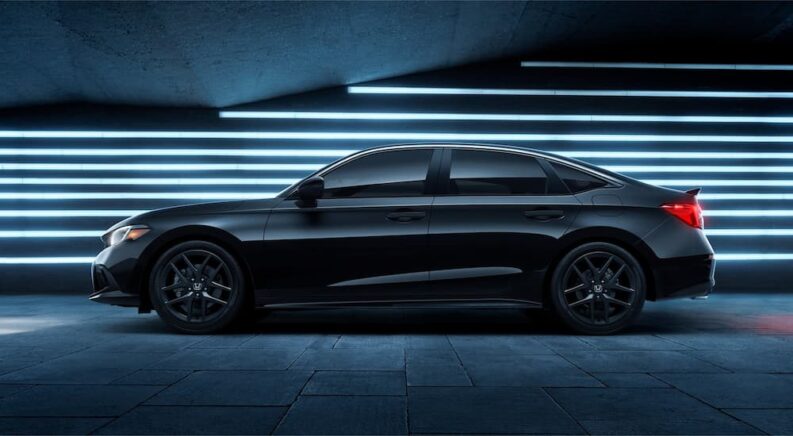When most people go to their local Honda dealer, they’re looking for practical, fuel-efficient vehicles that are good for getting around town or commuting to work. That doesn’t mean that the automaker has nothing to offer to enthusiasts, however. Case in point: the Civic Si. This model has been racking up fans for decades with its stellar performance, impressive handling, and exclusive interior, all at a price that non-millionaire enthusiasts can afford. Let’s take a look at the timeline of this legendary model and see how it has evolved over the years.
1973: The Civic Comes to America
There can be no Civic Si without the Civic itself. Just a year after its 1972 launch in Japan, the Civic came to the US in 1973. The compact car was originally available as either a three-door hatchback or a four-door sedan. In the decades since the Civic has also been available as a two-door coupe, five-door hatchback, and wagon. With that kind of versatility, it’s no wonder it also took on the Si badge in later years.
1986: American Debut of the Civic Si
The “Si” in Civic Si stands for “sport injection,” and it’s a badge that has graced multiple Honda models over the years. One of the first Si models to be available in the US was the Prelude Si, which hit the American market in 1985 and is still fondly remembered as a stylish performance car. The first Civic Si to grace American roads came along that same year in the form of the 1985 Civic CRX Si, a small two-door, two-seat hatchback that produced 91 horsepower. Of course, that figure would rise significantly over the years. Its success led to the creation of the Civic Si hatchback, a model that had both sports car performance and four-seat practicality. While some Civics were still carbureted, the addition of fuel injection to Si models was one of the reasons why they were more powerful.
1988: New Generation, New Design
Shortly after the fourth-generation Civic was introduced to the US, the second generation of the Civic Si made its debut. The body was redesigned for better aerodynamics and a more distinct look, with a low hood enhancing its silhouette and narrow headlights adding to its overall style. This generation saw fuel injection become standard across the entire Civic lineup. The Si now brought 108 horsepower to the table and came standard with a power sunroof.
1992: Civic Si Upgrades, Inside and Out
With the fifth generation of the Civic came the third generation of the Civic Si, which adopted the Civic’s new appearance with more rounded edges where there were once sharp corners. If you recall that “Si” stands for “sports injection,” you may wonder how the Si is different from other Civics if they’re all using injection technology. Honda made it work by giving the Si model variable intake-valve timing and valve lift, allowing the vehicle to adjust its settings at low and high speeds to provide more torque at low speeds and plenty of power at high speeds. This setup gave the Si 125 ponies to play with. On top of that, it got standard power steering for the first time, along with four-wheel disc brakes.
1999: Civic Si Prepares for a New Millennium
Between 1995 and 1999, the Civic Si took a short hiatus, but it returned just in time for the new millennium with the 1999 Civic Si Coupe. This model went harder than ever before on the performance angle, featuring a front strut-tower brace, stiffer springs, stiffer stabilizer bars, a larger exhaust system, and larger four-wheel disc brakes. Plus, the power made a huge leap up to 160 horsepower. These material upgrades were accompanied by sporty style additions, like an interior filled with red accents and a limited selection of bold color options: Electron Blue, Milano Red, and Flamenco Black.
2002: Civic Si the Only Hatchback for the US
For the 2002 model year, the Civic Si was available as a hatchback, and strangely it was the only hatchback in the Civic’s North American lineup for that year. Though it didn’t have a non-Si direct counterpart to compare it to, this iteration of the Si still stands strong, with a new engine that still produced 160 horsepower, but increased torque by 21 lb-ft, enabling it to go from zero to sixty in eight seconds. Another feature that makes this particular Civic Si unique is the “rally-style” dashboard-mounted gear lever. Though it looks rather strange to modern eyes, the lever’s placement put it in easy reach of the driver and didn’t diminish the smooth feel of the gearbox at all.
2007: First Civic Si Sedan
From hatchback to coupe to hatch again, the Si badge made its way to the Civic Sedan for the first time in the 2007 model year. Its debut came only a year after the 2006 Civic Si Coupe brought peak horsepower up to 197. Since the Civic Si Coupe also returned for the 2007 model year, this became the first time that drivers could choose between two different Civic Si body styles at the same time.
2008: Mugen Edition
For Honda, collaborating with engine tuner and parts manufacturer Mugen Motorsports is all in the family. Mugen was co-founded by Hirotoshi Honda, son of Honda founder Soichiro Honda. Mugen had worked on Civic variants before, including the 2009 Civic Dominator. The Mugen Edition of the 2008 Civic Si Sedan featured a range of changes, from a significant lift to exclusive wheels, an upgraded suspension, and a flashy rear wing, as well as exclusive interior style. The limited edition sold only 1,000 vehicles, all of which were painted in an eye-catching Fiji Blue.
2012: Bigger, Better Engine
The 2012 Civic Coupe featured the largest engine in Civic Si history, a 2.4L i-VTEC I-4 that could crank out 201 horsepower and 170 lb-ft of torque. By the end of this generation, the Si would once again be available as both a coupe and a sedan, packing 205 horsepower in either body style. An Si-exclusive interior continued to make the cabin feel sporty with a classic red and black colorway.
2017: Factory Turbocharging Kicks It Up a Notch
The 2017 model year saw a major change under the hood for the Civic Si coupe and sedan, the first use of turbocharging for a Civic Si. The old 2.4L engine was replaced with a 1.5L. While it had much less displacement, the new engine kept the horsepower figure the same at 205, and increased torque to 192 lb-ft. That power was also felt across a wider powerband, making the car feel more peppy overall. The 2017 Civic Si also added an adjustable suspension damper system with Normal and Sport modes, making it a more versatile vehicle.
2022: The Civic Si of Today
For the 2022 model year, the Civic Si was available as a sedan with a longer wheelbase than the outgoing model. A 1.5L turbocharged engine continues to power the car, now providing a peak of 200 horsepower and 192 lb-ft of torque at a lower rpm than before and holding power for longer. While the auto industry generally is leaving manual transmission behind these days, the Civic Si is sticking with tradition by offering a six-speed manual as the only transmission. The shifter also now has a shorter throw than before for snappier gear changes. Other changes include a stiffer body and a retuned suspension for more responsive handling. Red accents still grace the interior.
What’s Next for the Civic Si?
It’s impossible to say for sure what the future holds for this iconic model. We hope to see it stick around for years to come and look forward to seeing what new changes and special editions will be added to its storied history. Some form of electrification seems almost inevitable at some point, but the 2022 model does reflect Honda’s desire to keep the Si true to its roots, one of the few models available today retaining its manual transmission despite current trends. We’ll certainly keep an eye out to see what comes next.




